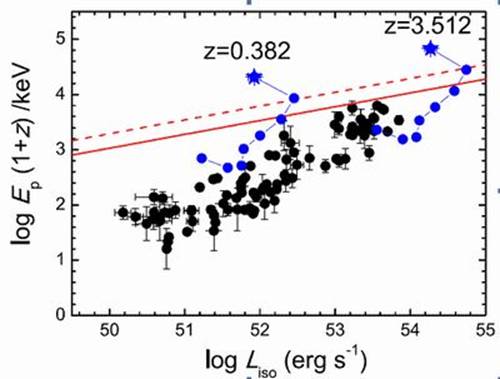
Figure. Rest-frame peak energy Ep(1 + z) is plotted against the observed isotropicγ-ray luminosity L for the time-resolved spectra of Fermi GRBs with redshift measurements. The black data points are from Figure 9 of Lu et al.(2012), but only the spectra during the rising phase of GRB pulses are taken. The blue points are the time-resolved spectra of GRB 110721A for the two candidate redshifts. The two stars are for the first epoch, which are both well beyond the death lines. Two death lines are plotted, which correspond to the fireball initial radius R0= 107 cm (solid) and 3×106 cm (dashed), respectively.
The prompt emission spectra of gamma-ray bursts (GRBs) usually have a dominant component that is well described by a phenomenological Band function. The physical origin of this spectral component is debated. Although the traditional interpretation is synchrotron radiation of non-thermal electrons accelerated in internal shocks or magnetic dissipation regions, the growing trend within the community is to interpret this component as modified thermal emission from a dissipative photosphere of a GRB fireball. In a recent work by PMO scientist Dr. Xuefeng Wu and his collaborators, they analyze the time-dependent spectrum of GRB 110721A detected by the Fermi Gamma-Ray Burst Monitor and Large Area Telescope, and pay special attention to the rapid evolution of the peak energy Ep.They define a “death line” of thermally dominated dissipative photospheric emission in the peak energy – luminosity (Ep–Liso) plane, and show that Ep of GRB 110721A at the earliest epoch has a very high Ep ∼ 15MeV that is beyond the “death line” (see the above figure). Together with the finding that an additional “shoulder” component exists in this burst that is consistent with a photospheric origin, the authors suggest that at least for some bursts, the Band component is not from a dissipative photosphere, but must invoke a non-thermal origin (e.g., synchrotron or inverse Compton) in the optically thin region of a GRB outflow. They also suggest that the rapid hard-to-soft spectral evolution is consistent with the quick discharge of magnetic energy in a magnetically dominated outflow in the optically thin region.
This work was recently published on the Astrophysical Journal, for more details see Bing Zhang, Rui-Jing Lu, En-Wei Liang, and Xue-Feng Wu, 2012, ApJ, 758, L34 http://iopscience.iop.org/2041-8205/758/2/L34
(Information source: Purple Mountain Observatory of CAS)

